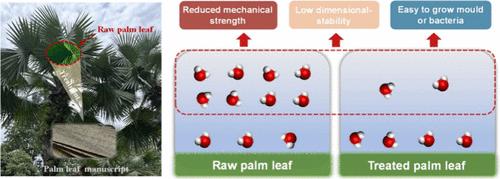Our official English website, www.x-mol.net, welcomes your
feedback! (Note: you will need to create a separate account there.)
Investigation on the Moisture Absorption Behaviors of Palm Leaves (Corypha umbraculifera) and Their Variation Mechanism
Langmuir ( IF 3.7 ) Pub Date : 2024-11-18 , DOI: 10.1021/acs.langmuir.4c03368 Zirui Zhu, Yuqing Jia, Hanwei Yu, Shuang Yu, Yangxin Zhou, Peng Liu, Hongbin Zhang, Yuliang Yang
Langmuir ( IF 3.7 ) Pub Date : 2024-11-18 , DOI: 10.1021/acs.langmuir.4c03368 Zirui Zhu, Yuqing Jia, Hanwei Yu, Shuang Yu, Yangxin Zhou, Peng Liu, Hongbin Zhang, Yuliang Yang

|
Palm leaves serve as a traditional recording medium and are widespread in south and southeast Asia, and they have a long history. However, they are sensitive to environmental fluctuations, especially moisture, which may severely affect their conservation status. In this research, the moisture absorption behaviors of palm leaves in different states, including raw, treated, naturally aged, and artificially aged ones, were investigated by intelligent gravimetric analysis (IGA) and water retention value (WRV) to analyze their moisture absorption characteristics. Mathematical model was employed to fit and analyze their water adsorption curves, aiming to explore the content and distribution of the adsorbed water in monolayered and multilayered. Then, the chemical and physical properties of different palm leaves were studied by chemical composition analysis, Fourier-transform infrared spectroscopy (FT-IR), X-ray diffraction (XRD), nitrogen adsorption, scanning electron microscopy (SEM), and low-field nuclear magnetic resonance (low-field NMR), and the relationship between moisture absorption characteristics and their chemical composition and physical structures was analyzed. The results demonstrated that both treatment and aging processes could have a noticeable impact on the moisture absorption of palm leaves, as evidenced by reduced equilibrium moisture content (EMC) at high relative humidity (RH), decreased multilayer water adsorption content, and slightly increased monolayer water adsorption content. Besides, palm leaves exhibit a lower rate of moisture adsorption, at ∼30–50% RH, which facilitates their long-term conservation. The results of chemical and physical analyses revealed that the reduced content of hydrophilic groups was the primary reason for a decrease in palm leaves moisture absorption. Additionally, the fiber structure changes of palm leaves caused by treatment or aging may have different influences on their moisture adsorption, especially the content of monolayer adsorbed water.
中文翻译:

棕榈叶 (Corypha umbraculifera) 吸湿行为及其变化机制的研究
棕榈叶是一种传统的记录媒介,广泛分布在南亚和东南亚,历史悠久。然而,它们对环境波动很敏感,尤其是水分,这可能会严重影响它们的保护状况。本研究通过智能重量分析 (IGA) 和保水值 (WRV) 研究了棕榈叶在不同状态下的吸湿行为,包括生叶、处理叶、自然老化叶和人工老化叶,以分析其吸湿特性。采用数学模型拟合分析其水吸附曲线,旨在探究单层和多层吸附水的含量和分布。然后,通过化学成分分析、傅里叶变换红外光谱 (FT-IR)、X 射线衍射 (XRD)、氮吸附、扫描电子显微镜 (SEM) 和低场核磁共振 (low-field NMR) 研究了不同棕榈叶的化学和物理性质,并分析了吸湿特性与其化学成分和物理结构之间的关系。结果表明,处理和老化过程都会对棕榈叶的吸湿性产生显著影响,高相对湿度 (RH) 下平衡水分含量 (EMC) 降低、多层水吸附含量降低和单层水吸附含量略有增加。此外,棕榈叶的水分吸附率较低,约为 30-50% RH,这有助于它们的长期保存。 化学和物理分析结果表明,亲水基团含量降低是棕榈叶吸湿性降低的主要原因。此外,棕榈叶因处理或老化引起的纤维结构变化可能对其水分吸附产生不同的影响,尤其是单层吸附水的含量。
更新日期:2024-11-18
中文翻译:

棕榈叶 (Corypha umbraculifera) 吸湿行为及其变化机制的研究
棕榈叶是一种传统的记录媒介,广泛分布在南亚和东南亚,历史悠久。然而,它们对环境波动很敏感,尤其是水分,这可能会严重影响它们的保护状况。本研究通过智能重量分析 (IGA) 和保水值 (WRV) 研究了棕榈叶在不同状态下的吸湿行为,包括生叶、处理叶、自然老化叶和人工老化叶,以分析其吸湿特性。采用数学模型拟合分析其水吸附曲线,旨在探究单层和多层吸附水的含量和分布。然后,通过化学成分分析、傅里叶变换红外光谱 (FT-IR)、X 射线衍射 (XRD)、氮吸附、扫描电子显微镜 (SEM) 和低场核磁共振 (low-field NMR) 研究了不同棕榈叶的化学和物理性质,并分析了吸湿特性与其化学成分和物理结构之间的关系。结果表明,处理和老化过程都会对棕榈叶的吸湿性产生显著影响,高相对湿度 (RH) 下平衡水分含量 (EMC) 降低、多层水吸附含量降低和单层水吸附含量略有增加。此外,棕榈叶的水分吸附率较低,约为 30-50% RH,这有助于它们的长期保存。 化学和物理分析结果表明,亲水基团含量降低是棕榈叶吸湿性降低的主要原因。此外,棕榈叶因处理或老化引起的纤维结构变化可能对其水分吸附产生不同的影响,尤其是单层吸附水的含量。


















































 京公网安备 11010802027423号
京公网安备 11010802027423号